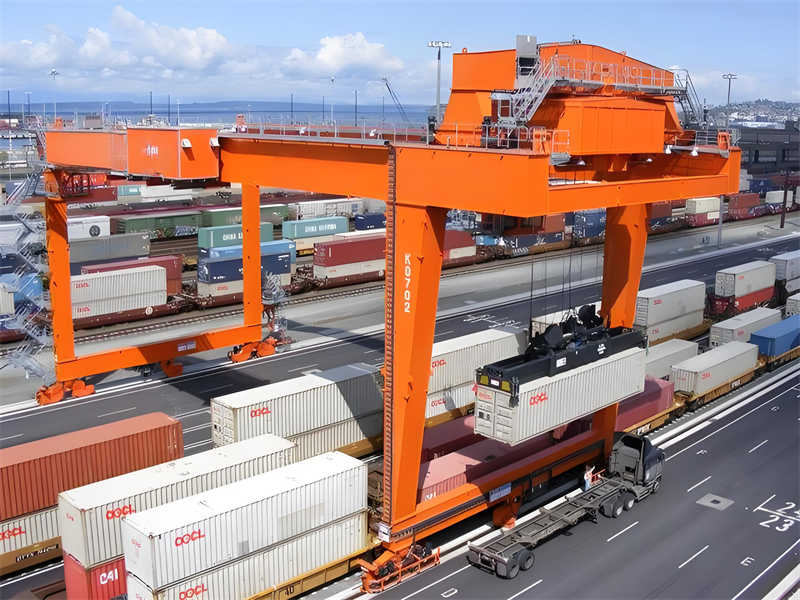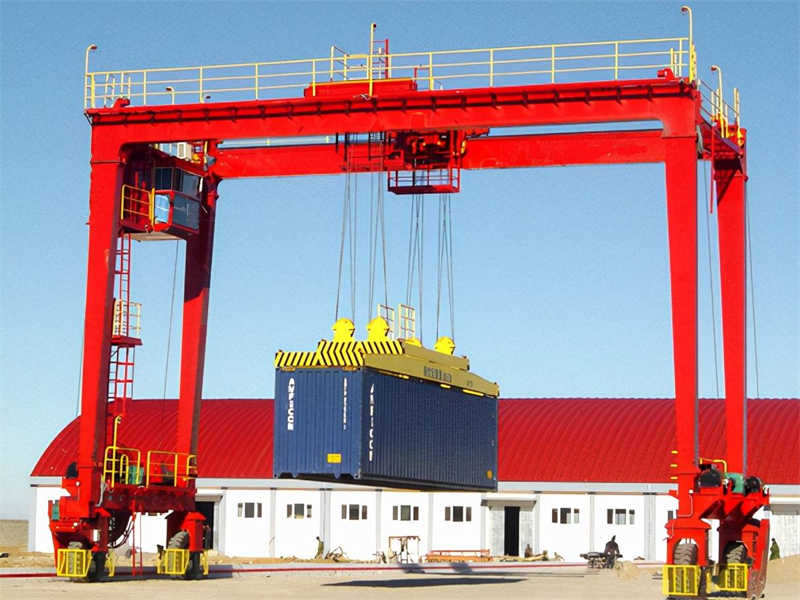12-Jun-2025
Container Crane Buying Guide: Rail-Mounted (RMG) vs. Rubber-Tyred (RTG) – Which is Right for Your Operation?
– Professional Insights from Dongqi Crane, Your Trusted Crane Manufacturer
1. Introduction
Choosing the right container handling crane is critical for optimizing port operations, intermodal yards, and logistics terminals. As a leading global crane manufacturer, Dongqi Crane provides this comprehensive comparison between Rail-Mounted Gantry Cranes (RMG) and Rubber-Tyred Gantry Cranes (RTG) to help you make an informed decision based on your operational needs, budget, and long-term goals.
2. What is a Rail-Mounted Gantry Crane (RMG)?

Technical Definition and Core Components
A Rail-Mounted Gantry Crane (RMG) represents a sophisticated material handling system specifically engineered for high-volume container operations in structured terminal environments. At its core, an RMG system consists of a rigid steel bridge structure supported by two or more legs that travel along fixed parallel rails embedded in the terminal surface. The fundamental architecture comprises three primary subsystems: the gantry framework (including the boom, trolley, and spreader mechanisms), the rail running gear with precision guidance systems, and the power distribution network (typically utilizing conductor bars or festoon systems).
Operational Characteristics and Performance Metrics
Modern RMG systems demonstrate exceptional performance characteristics, with typical operational parameters including:
- Lifting capacities ranging from 30 to 100 metric tons
- Span widths adjustable between 18 to 50 meters
- Lifting heights reaching up to 40 meters above rail
- Operating speeds of 30-50 m/min for trolley travel
- Container handling rates of 20-35 moves per hour in optimal conditions
The fixed rail installation provides inherent advantages in operational precision, with modern RMGs achieving positioning accuracy within ±5mm, a critical factor for high-density container stacking operations. This level of precision enables safe container handling in tight configurations, with some advanced systems capable of stacking containers up to 7 high and 6 deep in block storage configurations.
Power Systems and Energy Efficiency
Contemporary RMG designs predominantly utilize electric power distribution systems, with several distinct configurations available:
- Conductor Bar Systems: Provide continuous power through sliding contacts
- Cable Reel Systems: Employ rotating drums for power cable management
- Hybrid Systems: Combine grid power with onboard energy storage
Energy efficiency represents a key advantage of RMG technology, with regenerative braking systems capable of recovering up to 30% of operational energy during lowering and braking operations. Modern RMGs typically consume 15-25% less energy per container move compared to rubber-tired alternatives, with power requirements averaging 80-120 kWh per operating hour depending on duty cycle.
Structural Engineering and Load Management
The structural design of RMG systems incorporates several critical engineering considerations:
- Box girder construction for main bridges, utilizing high-strength steel (typically S355 or equivalent)
- Redundant load path design for critical structural members
- Finite element analysis (FEA) optimized stress distribution
- Dynamic load factoring for seismic and wind conditions
Load management systems include:
- Automatic load moment indicators (LMI)
- Anti-collision systems with laser scanning
- Dynamic sway control algorithms
- Twistlock verification systems
Automation Integration Capabilities
RMG technology has proven particularly amenable to automation integration, with multiple implementation levels:
- Semi-Automated Systems: Operator-assisted positioning
- Process Automation: Automated travel and container handling sequences
- Full Automation: Complete unmanned operation with remote monitoring
Automated RMG systems typically incorporate:
- Optical character recognition (OCR) for container identification
- Laser-based positioning systems
- Automated spreader adjustment
- Integrated container management system interfaces
3. What is a Rubber-Tyred Gantry Crane (RTG)?

Technical Definition and Core Components
A Rubber-Tyred Gantry Crane (RTG) is a highly mobile container handling system characterized by its wheel-mounted configuration, offering unparalleled flexibility in terminal operations. The system’s architecture consists of a reinforced steel gantry frame mounted on rubber-tired bogies, typically featuring 4 to 8 wheels depending on load requirements. Key subsystems include:
- The portal frame structure with cantilevered boom
- Hydraulic or electric wheel drive assemblies
- Container spreader with twistlock mechanism
- Power plant (diesel, electric, or hybrid)
- Sophisticated steering and stabilization systems
Operational Characteristics and Performance Metrics
Modern RTG systems demonstrate versatile performance capabilities:
- Lifting capacities ranging from 30 to 60 metric tons
- Span widths accommodating 1-over-5 to 1-over-7 container rows
- Lifting heights reaching 15-18 meters (stacking 5-6 high)
- Travel speeds of 50-90 m/min (unloaded)
- Container handling rates of 15-25 moves per hour
- Turning radius as tight as 15 meters in some configurations
Power Systems and Energy Options
RTG technology offers multiple power configurations to suit different operational needs:
- Diesel-Electric Systems
- Conventional configuration with diesel generator sets
- Typical fuel consumption of 15-25 liters/hour
- Power output ranging from 150-400 kW
- Hybrid Systems
- Combine diesel generators with battery banks
- Energy recovery during lowering operations
- Fuel savings of 30-50% compared to conventional systems
- Full Electric Systems
- Cable reel or conductor bar power supply
- Zero local emissions operation
- Growing adoption in environmentally sensitive areas
Mobility and Steering Systems
RTG mobility represents its key differentiator, enabled by advanced steering technologies:
- 90° cross-traffic steering for container block transfers
- Parallel mode for long-distance travel
- Crab steering for precise positioning
- Automated steering correction systems
- Laser or GPS-guided path following in automated versions
Structural Design Innovations
Modern RTG designs incorporate several engineering advancements:
- Variable geometry booms for different stacking configurations
- Lightweight high-strength steel alloys (HSLA grades)
- Dynamic load balancing systems
- Retractable cantilevers for reduced swept area
- Container profile scanners for safe operation
Automation and Control Systems
RTG technology has seen significant automation advancements:
- Remote operation stations with 3D visualization
- Automated container positioning within stacks
- Collision avoidance systems using LiDAR
- Container identification through RFID/OCR
- Fleet management system integration
Maintenance Requirements and Service Life
RTG maintenance differs significantly from RMG systems due to mobile components:
- Daily tire pressure and wear inspections
- Weekly engine and transmission checks (for diesel units)
- Monthly structural integrity inspections
- Quarterly wheel bearing servicing
- Annual major component overhauls
Typical service life ranges from 15-20 years, with mid-life refurbishments often extending this to 25+ years. Modern designs emphasize:
- Quick-change component systems
- Predictive maintenance technologies
- Modular power train replacements
- Corrosion protection for marine environments
Application Scenarios and Operational Advantages
RTG systems excel in several operational contexts:
- Medium-volume terminals (100,000-1,000,000 TEU annually)
- Multi-purpose terminals with varied cargo flows
- Terminals anticipating layout changes
- Facilities with space constraints
- Operations requiring equipment redeployment
Key advantages include:
- Rapid deployment without extensive infrastructure
- Layout flexibility for operational changes
- Lower initial capital investment
- Ability to work in unpaved areas
- Gradual automation upgrade path
4. RMG vs. RTG: Key Comparison Factors
1. Infrastructure Requirements & Site Preparation
RMG Systems:
- Require permanent rail installation (typically $300-$500 per linear meter)
- Need substantial subgrade preparation with:
- 1.5-2.0m deep concrete foundations
- Continuous rail beam support structures
- Precise leveling (±2mm tolerance over 50m)
- Demand minimum 30m clear zones on each side
- Installation timeline: 9-18 months for complete system
RTG Systems:
- Require only paved surface (asphalt or concrete)
- Surface specifications:
- 300mm compacted subbase
- 200mm reinforced concrete (35MPa)
- Flatness tolerance ±10mm over 10m
- Can be operational within 3-6 months
- Allow phased infrastructure development
2. Operational Performance Metrics
| Parameter | RMG | RTG |
|---|---|---|
| Positioning Accuracy | ±5mm | ±50mm (basic) ±10mm (automated) |
| Max Stack Height | 7-high | 5-6 high |
| Container Moves/Hour | 25-35 | 15-25 |
| Peak Productivity | 500-700 TEU/shift | 300-450 TEU/shift |
| Acceleration Rate | 0.3-0.5 m/s² | 0.2-0.4 m/s² |
| Operational Availability | 98.5% | 96% |
3. Cost Analysis (10-Year Lifecycle)
Capital Expenditure:
- RMG: $4-6 million per crane + $2-3 million rail infrastructure
- RTG: $1.2-2.5 million per unit (no rail costs)
Operating Costs:
- RMG: $8-12 per container move (electric power)
- RTG: $15-25 per move (diesel) / $10-18 (electric)
Maintenance Costs:
- RMG: $150,000-$250,000 annually
- RTG: $200,000-$350,000 (including tire replacement)
4. Automation Potential
RMG Automation:
- Mature technology with 15+ years implementation history
- Achieves 30-35 moves/hour automated
- Requires $500k-$1M additional investment per crane
- Integration time: 3-6 months
RTG Automation:
- Emerging technology (5-7 years field experience)
- Current capability: 20-25 moves/hour automated
- Upgrade cost: $750k-$1.2M per unit
- Requires terminal-wide navigation infrastructure
5. Energy Consumption & Sustainability
Power Requirements:
- RMG: 80-120 kWh/hour continuous
- RTG: 15-25 liters diesel/hour (hybrid) or 90-150 kWh (electric)
Environmental Impact:
- RMG:
- Zero direct emissions
- 35-45 dB noise at 25m
- 100% recyclable steel structure
- RTG:
- Tier 4 Final: 0.4g/kWh NOx (diesel)
- 65-75 dB noise at 25m
- Tire disposal challenges (8-10 tires/year)
6. Layout Flexibility & Scalability
RMG Constraints:
- Fixed operating lanes
- Difficult to modify after installation
- Expansion requires complete new rail lines
- Best for terminals >50 hectares
RTG Advantages:
- Dynamic lane reconfiguration
- Gradual capacity increases possible
- Easy relocation between yards
- Suitable for 10-50 hectare terminals
7. Weather & Environmental Resilience
Storm Resistance:
- RMG: Withstands 45m/s winds when parked
- RTG: Requires tie-down at 25m/s winds
Extreme Temperatures:
- RMG: Operational -30°C to +50°C
- RTG: Requires modifications below -20°C
Seismic Performance:
- RMG: Designed for 0.3-0.5g seismic zones
- RTG: Limited to 0.2g zones without modifications
8. Labor Requirements
RMG Operations:
- 1 operator per 2-3 cranes (automated)
- Small maintenance crew (2-3 technicians)
RTG Operations:
- 1 operator per crane (manual)
- 4-5 person maintenance team
- Additional traffic coordinators needed
9. Safety Considerations
RMG Advantages:
- Fixed collision avoidance zones
- Predictable movement patterns
- Enclosed operator cabins
RTG Risks:
- Ground personnel interaction
- Blind spot challenges
- Tire burst potential
10. Technology Roadmap & Future-Proofing
RMG Developments:
- AI-based predictive maintenance
- Ultra-high density stacking (9-high)
- 10MW+ regenerative power systems
RTG Innovations:
- Autonomous swarm operations
- Hydrogen fuel cell integration
- Self-healing tire technologies
Dongqi Crane Recommendation Matrix:
| Terminal Characteristic | Recommended Solution |
|---|---|
| Annual Volume >800k TEU | RMG |
| Layout Changes Expected | RTG |
| Strict Emission Rules | Electric RMG/RTG |
| Limited Capital Budget | RTG |
| High Automation Goals | RMG |
| Multi-Tenant Operation | RTG |
| Harsh Weather | RMG |
| Phased Development | RTG |
5. Which Should You Choose? RMG or RTG?
Choose RMG If:
✅ Your terminal has a fixed, high-density layout.
✅ You prioritize long-term cost savings and automation.
✅ You need high-precision stacking (e.g., busy ports).
Choose RTG If:
✅ Your terminal layout changes frequently.
✅ You need quick deployment and mobility.
✅ You have budget constraints (lower upfront cost).
Dongqi Crane Recommendation: Large ports often combine RMGs for stacking and RTGs for flexibility.
6. Future Trends in Container Cranes
- Smart Automation: AI-driven RTGs with remote control.
- Green Energy: Hydrogen-powered and full-electric cranes.
- Hybrid Models: Combining RMG precision with RTG mobility.
Dongqi Crane’s Innovation: We lead in automated, energy-efficient cranes tailored for Industry 4.0 ports.
7. Conclusion
The choice between RMG and RTG cranes depends on your port size, budget, and operational needs.
For Expert Guidance:
🔹 Contact Dongqi Crane for a customized crane solution.
🔹 Explore our RMG and RTG product catalog for specifications.

